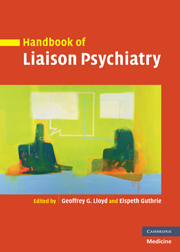Book contents
- Frontmatter
- Contents
- List of contributors
- Preface
- Part I Basic skills
- Part II Common psychiatric problems across the general hospital
- Part III Working with specific units
- 14 Neurological disorders
- 15 Cardiorespiratory disorders
- 16 Gastrointestinal disorders
- 17 Liver disorders
- 18 Endocrine disorders
- 19 Diabetes
- 20 HIV and AIDS
- 21 Renal disease
- 22 Musculo-skeletal disorders
- 23 Oncology
- 24 Head and neck cancer
- 25 Palliative care
- 26 Cosmetic procedures
- 27 Perinatal and gynaecological disorders
- 28 The intensive care unit
- 29 The burns unit
- 30 Psychocutaneous disorders
- 31 Genitourinary disorders
- 32 The emergency department
- Part IV Treatment
- Part V Different treatment settings
- Index
- References
19 - Diabetes
from Part III - Working with specific units
Published online by Cambridge University Press: 10 December 2009
- Frontmatter
- Contents
- List of contributors
- Preface
- Part I Basic skills
- Part II Common psychiatric problems across the general hospital
- Part III Working with specific units
- 14 Neurological disorders
- 15 Cardiorespiratory disorders
- 16 Gastrointestinal disorders
- 17 Liver disorders
- 18 Endocrine disorders
- 19 Diabetes
- 20 HIV and AIDS
- 21 Renal disease
- 22 Musculo-skeletal disorders
- 23 Oncology
- 24 Head and neck cancer
- 25 Palliative care
- 26 Cosmetic procedures
- 27 Perinatal and gynaecological disorders
- 28 The intensive care unit
- 29 The burns unit
- 30 Psychocutaneous disorders
- 31 Genitourinary disorders
- 32 The emergency department
- Part IV Treatment
- Part V Different treatment settings
- Index
- References
Summary
Introduction
Diabetes mellitus is one of the most common chronic diseases worldwide and is characterized by chronic hyperglycaemia. The prevalence of detected diabetes is around 3–4% in the general population and increasing largely due to the epidemic of obesity and to improved survival rates (Amos et al. 1997). Diabetes mellitus presents specific challenges to the liaison psychiatrist additional to those common to chronic disease conditions as the management and prognosis is largely based on the patient taking responsibility for multiple self-care tasks such as diet, exercise, weight reduction, self-monitoring of glucose, foot care and injection sites and adhering to oral medication and insulin injections.
Despite the high prevalence of diabetes in the general medical setting and good evidence that mental health problems are common and reduce life expectancy, the development of diabetes-specific liaison mental health services is sporadic and piecemeal. We begin by giving an outline of the clinical features of diabetes. This is followed by a review of the psychiatric and psychological factors associated with diabetes. Finally a summary of the evidence of the effectiveness of pharmacological and psychological interventions is examined.
Clincial features of diabetes mellitus
An increasing understanding of the aetiology of diabetes and advances in treatment recently led to a new classification comprising four types of diabetes based on pathology of the underlying condition rather than on the nature of treatment (Alberti & Zimmett 1998; Expert Committee on the Diagnosis and Classification of Diabetes Mellitus 1997).
Keywords
- Type
- Chapter
- Information
- Handbook of Liaison Psychiatry , pp. 454 - 473Publisher: Cambridge University PressPrint publication year: 2007



